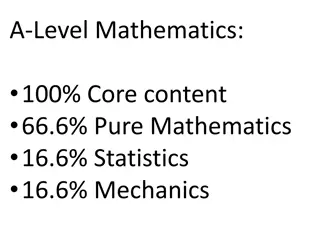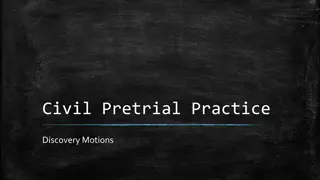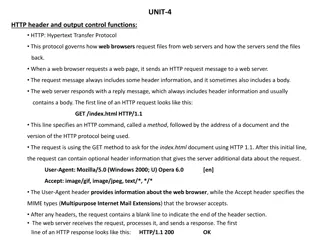
Understanding Secure HTTP and Cryptography Basics
Explore the fundamentals of Secure HTTP, including its vulnerabilities and solutions, along with an overview of the Internet Protocol Suite. Delve into the world of cryptography with insights on symmetric and asymmetric encryption, as well as public key cryptography.
Download Presentation

Please find below an Image/Link to download the presentation.
The content on the website is provided AS IS for your information and personal use only. It may not be sold, licensed, or shared on other websites without obtaining consent from the author. If you encounter any issues during the download, it is possible that the publisher has removed the file from their server.
You are allowed to download the files provided on this website for personal or commercial use, subject to the condition that they are used lawfully. All files are the property of their respective owners.
The content on the website is provided AS IS for your information and personal use only. It may not be sold, licensed, or shared on other websites without obtaining consent from the author.
E N D
Presentation Transcript
Further HTTP COMP3220 Web Infrastructure COMP6218 Web Architecture Dr Nicholas Gibbins nmg@ecs.soton.ac.uk
Overview Secure HTTP HTTP/2.0 WebDAV 3 3
The Internet Protocol Suite Application Layer process-to-process HTTP, SMTP, FTP, DNS, SSH, IMAP, POP... Transport Layer host-to-host Transmission Control Protocol (TCP) User Datagram Protocol (UDP) Internet Layer addressing and routing Internet Protocol (IP) Link Layer physical transmission Ethernet 802.11 (WiFi) 4
Securing HTTP As designed, HTTP sends all data in the clear Vulnerable to interception by third parties GET uri 200 OK 6 6
Transport Layer Security The foundation for Secure HTTP (HTTPS) Formerly known as Secure Sockets Layer (SSL) Protocol for establishing secure communications channels between internet hosts Despite the name, considered an application layer protocol 7 7
Cryptography 101 Symmetric Encryption Uses a single key for both encryption and decryption Generally fast Key exchange is an issue decrypt encrypt plain text cypher text plain text 8
Cryptography 101 Asymmetric Encryption Keys are generated in pairs Each key can decrypt only what the other has encrypted Given one key from a pair, cannot deduce the other key Generally slower than symmetric encryption 9
Cryptography 101 Public Key Cryptography Commonly-used term for asymmetric encryption Refers to the different roles of the keys in a pair Public key Shared with all by the owner Used to encrypt messages sent to the owner Private key Kept a secret by the owner Used by the owner to decrypt messages sent to them 10 10
Cryptography 101 Digital signatures Authentication, non-repudiation, integrity of messages 1. Generate a cryptographic hash of the message 2. Encrypt the hash with your private key hash # # 11
Cryptography 101 Signature verification 1. Decrypt the encrypted hash with the public key 2. Generate a cryptographic hash of the message 3. Compare the hashes # hash compare # # 12
Cryptography 101 Certificates A public key that has been digitally signed by a trusted third party (a Certification Authority) Used to make guarantees about ownership of a public key CA public keys typically incorporated into browsers or operating systems 13
Transport Layer Security handshake Key to understanding TLS is the handshake Protocol used by client and server to agree on a shared symmetric key Method of agreement means that a malicious third party: can t work out the shared key can t replay old messages Shared key used to encrypt all subsequent communication in the session 14 14
server private key CA public key server public key (signed by CA) generate random number n ClientHello n generate random number m ServerHello m ServerHelloDone verify server public key generate pre-master secret ClientKeyExchange decrypt pre-master secret generate master secret from generate master secret from ChangeCipherSpec n m n m Finished ChangeCipherSpec Finished begin secure communication begin secure communication 15
HTTPS HTTP over a TLS connection Standard port is 443 (as opposed to port 80 for HTTP) 16 16
HTTP Limitations In order to fetch multiple resources from a server, HTTP/1.0 opens multiple connections to that server Extra costs in connection set-up/teardown Increased latency if connections are not concurrent Two partial solutions Reuse connections HTTP Keep-Alive Service requests in parallel HTTP Pipelining 18
Communication Speed Upper limit on speed of communication is the speed of light: c = 300,000,000 m/s ~20,000 km Actual speed of communication will be lower Optical fibre is typically ~70% of c Coaxial cable may be >80% of c Routers, switches, etc introduce delays Assuming no additional delays, a packet sent halfway round the world will take a minimum of 0.066 s to reach its destination Image: NASA 19
TCP Set-up and Teardown TCP provides a reliable connection Guarantees that packets will eventually reach their destination Lost packets are resent TCP establishes this connection using a three-way handshake SYN, SYN/ACK, ACK SYN 0.066 s SYN/ACK 0.066 s 0.2 s Lower limit for the duration of this exchange to a host at the antipodes: 0.2 s for one TCP connection at the speed of light without additional delays before any additional overhead from the TLS handshake ACK 0.066 s 20
HTTP/1.0 and earlier Before HTTP/1.1, each HTTP request used a separate TCP connection GET Expensive and time-consuming! 3-way handshake for each TCP open 4-way handshake for each TCP close Latency issues TCP open 200 OK TCP close GET TCP open 200 OK Some clients open multiple connections at same time Increased server load to handle many simultaneous connections TCP close TCP open GET 200 OK TCP close 21
HTTP Keep-Alive HTTP/1.1 introduced keep-alive TCP connections reused for multiple HTTP requests one TCP open and TCP close handshake GET TCP open 200 OK Still latency issues, but now in the application layer rather than the transport layer GET 200 OK GET 200 OK TCP close 22
HTTP Pipelining Also available from HTTP/1.1 Pipelining allows multiple requests to be made without waiting for responses Server must send responses in same order as received requests Reduces application layer latency GET TCP open GET GET 200 OK 200 OK 200 OK TCP close 23
SPDY Not an acronym - pronounced speedy Development between Google and Microsoft Preserves existing HTTP semantics SPDY is purely a framing layer Basis for HTTP/2.0 Offers four improvements over HTTP/1.1: Multiplexed requests Prioritised requests Compressed headers Server push 24 24
HTTP/2.0 Prioritised Requests A connection may contain multiple streams (each of which consists of a sequence of frames) Each stream has a 31-bit identifier Odd for client-initiated Even for server-initiated Each stream has another 31-bit integer that expresses its relative priority Frames from higher priority streams sent before those from lower priority streams Allows asynchronous stream processing (unlike HTTP/1.1 Pipelining) 25 25
HTTP/2.0 Compressed Headers HTTP/1.1 can compress message bodies using gzip or deflate Sends headers in plain text HTTP/2.0 also provides the ability to compress message headers 26 26
HTTP/2.0 Push HTTP/1.1 servers only send messages in response to requests HTTP/2.0 enables a server to pre-emptively send (or push) multiple associated resources to a client in response to a single request. 27 27
WebDAV HTTP/1.1 still essentially a read-only protocol, as deployed Web Distributed Authoring and Versioning Extension to HTTP Most recent version from 2007 RFC4918 29
WebDAV versus HTTP Extra methods: PROPFIND retrieve resource metadata PROPPATCH change/delete resource metadata MKCOL create collection (directory) COPY/MOVE copy or move resource LOCK/UNLOCK lock/release resource (so others can t change it) Extra headers: DAV: <compliance class> Extra status codes 30 30
WebDAV Implementations Supported by common servers (Apache, IIS, nginx) Not typically supported in Web browsers! Typically supported at an operating system level to talk to remote file systems as an alternative to things like SMB/CIFS Also in things like Apple s CalDAV and CardDAV protocols for handling calendars and address books 31 31
Next Lecture: Representational State Transfer

![❤[PDF]⚡ Civil War Talks: Further Reminiscences of George S. Bernard and His Fel](/thumb/20551/pdf-civil-war-talks-further-reminiscences-of-george-s-bernard-and-his-fel.jpg)




















